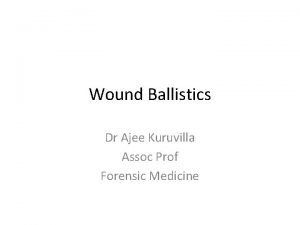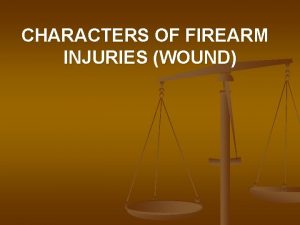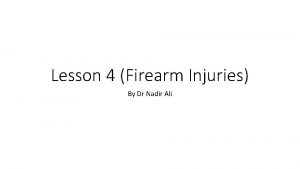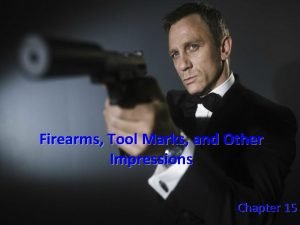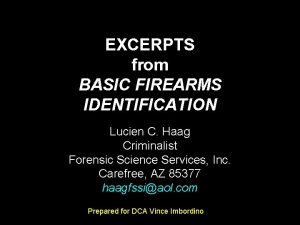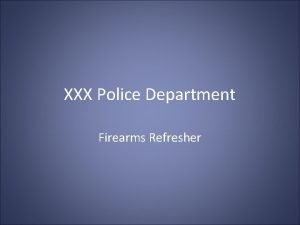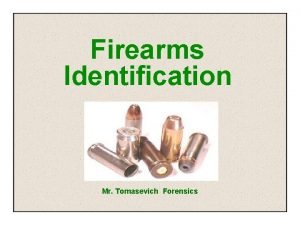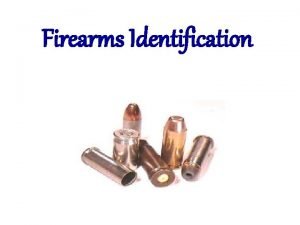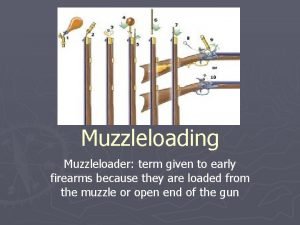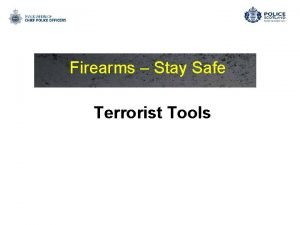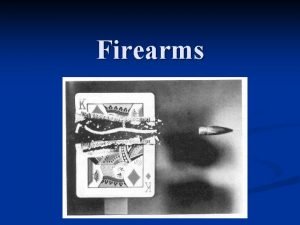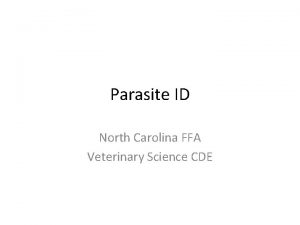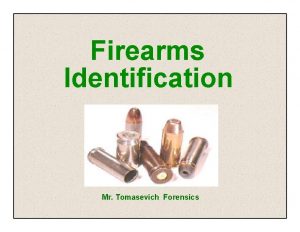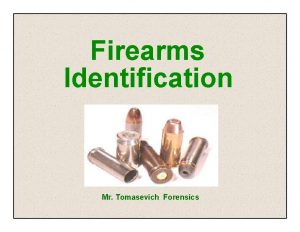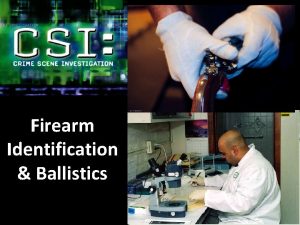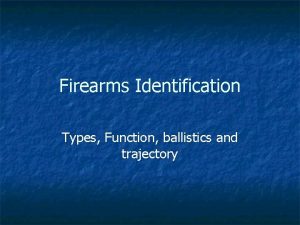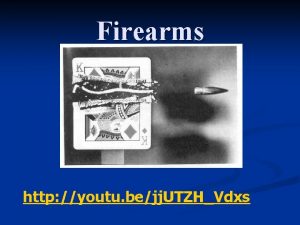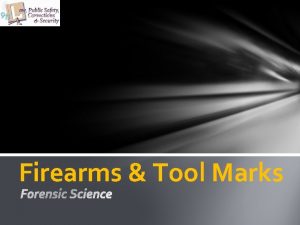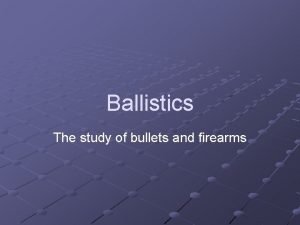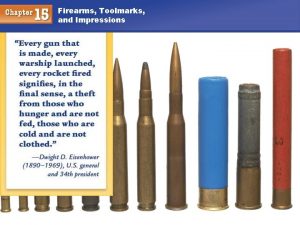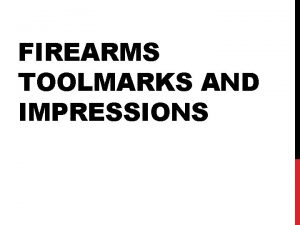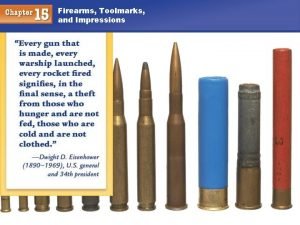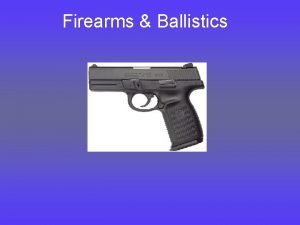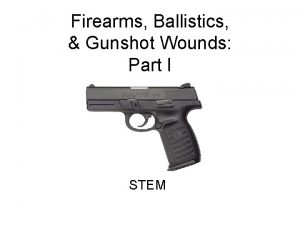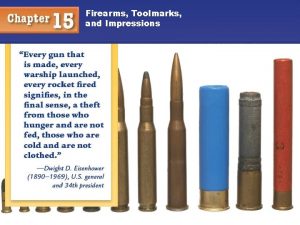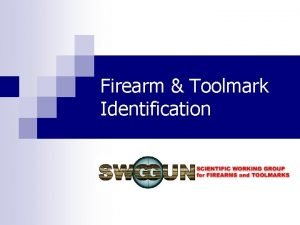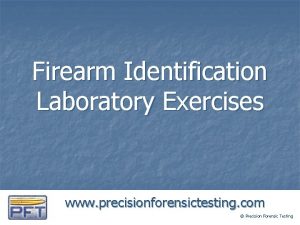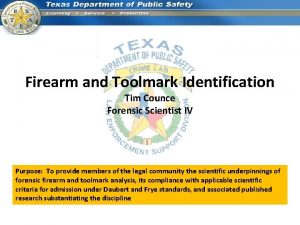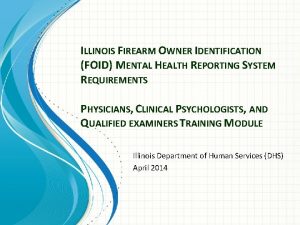Firearm Identification THE SCIENCE OF FIREARMS IDENTIFICATION INCLUDES









































- Slides: 41

Firearm Identification

THE SCIENCE OF FIREARMS IDENTIFICATION INCLUDES: • Comparison of bullets and cartridge casings As well as: • Knowledge of all types of weapons • Restoration of obliterated serial numbers on weapons • Detection and characterizations of gunpowder residue on garments / around wounds / hands • Estimation of muzzle-to-target distances

Ballistics is the study of the trajectory taken by bullets!

• There are literally thousands of types of firearms! They can be classified as shoulder firearms (rifles and shotguns) and handguns (pistols, revolvers, etc)


Revolver

Semiautomatic


Firearms can also be classified as “smoothbore” (shotguns) or “rifled” (most other weapons)

• A gun barrel is produced from a solid bar of steel by drilling. The manufacture of a barrel also requires the impression of spiral grooves on the inner surface. This is called “rifling”. The surfaces of the original bore are called lands. The diameter of a gun barrel, measured land to opposite land is called the “caliber” of the weapon. It is measured in hundredths of an inch or in mm • The lands and grooves guide the bullet through the barrel, giving it spin, so that it does not tumble, thus increasing its speed and force

CALIBER

Land Groove Caliber Land Groove Land If this is a land Impression, what are The other areas?

• Every firearms manufacturer chooses a rifling process, giving the weapon class characteristics. Frequently, a firearms examiner is given a spent bullet without a weapon. The caliber, weight, etc. help determine the weapon. The FBI maintains a record of class characteristics known as the GRCF (Gallery Rifle Centre Fire).

Bullets

Full Metal Jacket vs Hollow Point • Some bullets are described as full metal jackets (FMJ) and some are described as hollow points (HP). – A hollow point is designed to stay inside the victim, as to not potentially exit the victim and strike someone else. – These bullets are often used by police so that other spectators aren’t injured. – A full metal jacket is designed to pass through the victim.

Bullet Types

• The marks or striations on the inner surface of the barrel are randomly irregular and make each unique. As the bullet passes through the barrel, its surface is impressed with unique rifled marks of the barrel. • There are small changes due to grit, dust, & wear. • Recovered evidence bullets may become so distorted on impact as to yield only a small area with markings.

22 caliber copper-washed and plain lead bullets. 9 mm LUGER caliber G. F. L. (Fiocchi) FMJ bullets. 32 S&W LONG caliber plain lead bullet. 38 SPECIAL caliber plain lead bullet.

A comparison microscope is used to compare striation marks. No rules govern the points needed for bullet comparison.

A bullet is slightly larger in diameter than the bore diameter of the barrel in which it is designed to be fired. The bore diameter is the distance from one land to the opposite land in a barrel. As a result, a rifled barrel will impress a negative impression of itself on the sides of the bullet like those seen below.

Water tank Weapons are test fired into a recovery tank containing water

Pulling the trigger serves to release the weapon’s firing pin, causing it to strike the primer, which ignites the powder. The burning gunpowder generates gases that expand propel the bullet forward, and the spent cartridge case back against breechback. The shell therefore also has unique markings!

Bullet and cartridge case identification through comparison microscope

Comparison microphotograph of two bullets

Land Impression Striations 380 AUTO caliber FMJ bullets fired from a EAA Corp. pistol. 9 mm LUGER caliber FMJ bullets fired from a BROWNING pistol.

Groove Impression Striations 38 SPECIAL caliber SJHP bullets fired from a TAURUS revolver. 38 SPECIAL caliber lead bullets fired from a ROHM revolver.

A shotgun shell is diagrammed below: Gauge: Refers to the diameter of the barrel on a shotgun in terms of the number of lead balls the size of the bore it would take to weigh one pound (10 gauge, 12 gauge, etc. ) ". 410 gauge" really refers to caliber, but is worded as such to refer to a shotgun.

Bullets, shot pellets, and other projectiles may be recovered from the crime scene or from the bodies of shooting victims. Fired cartridge cases, fired shot shells, shot shell wadding, unfired ammunition and components may also have evidentiary value.

Types of Breech Marks Parallel breech marks Circular breech marks Mottled breech marks

Matching breech marks Firing pin impressions Breech marks do not match 38 SUPER AUTO cartridge cases fired in a COLT pistol.

Drugfire Computerized Firearms Comparison System


Gunshot Residue The deposition of gunshot residue on evidence such as clothing varies with the distance from the muzzle of the firearm to the target. Patterns of gunshot residue can be duplicated using a questioned firearm and ammunition combination fired into test materials at known distances. These patterns serve as a basis for estimating muzzle-togarment distances. Gunshot residue patterns.

Muzzle Blast of a Shotgun

T-shirt chemically treated for the presence of lead residue. Heavy deposits of lead found along left shoulder.

Close-up of bullet entrance hole in above shirt. Lead bullet wipe residues (pink) noted around the hole.

9 -inch test standard showing visible particulate residue (lead, burned and unburned gunpowder) and vaporous lead (pink) residues.

3 -inch test standard showing a very concentrated deposit of soot and vaporous lead residues. Griess Test from the 3 -inch test standard. Orange color is a positive reaction to a presence of a pattern of nitrite residues.


Soot is seen on the hand of a suicide victim, giving an indication that he was holding the weapon when it was fired.

Collection and Preservation of Firearms Evidence • Never stick an object into the barrel • Pick up the gun by the edge of the trigger guard or on the checkered portion of the grip – these areas do not usually retain prints • Weapons recovered in water must be transported to the lab in the same water in order to prevent rusting in transit • Ammunition must never be dug out of a wall or other surface – remove the whole section surrounding the bullet in order to reduce the possibility of adding any stray scratches, etc.
 Singeing blackening tattooing
Singeing blackening tattooing Characters of firearm injuries
Characters of firearm injuries Blowback phenomenon wound
Blowback phenomenon wound Rifled barrel
Rifled barrel Chapter 15 firearms toolmarks and impressions
Chapter 15 firearms toolmarks and impressions Mptc firearms instructor manual
Mptc firearms instructor manual Firearms
Firearms Virginia state police firearms transaction center
Virginia state police firearms transaction center Police xxx
Police xxx Rifling definition forensics
Rifling definition forensics Bullet
Bullet Firearms
Firearms Waryas foxboro
Waryas foxboro Firearms
Firearms Drugfire
Drugfire Firearms
Firearms Cdc firearms
Cdc firearms Describe your favourite subject
Describe your favourite subject Presumptive identification vs positive identification
Presumptive identification vs positive identification Dipylidium
Dipylidium Hát kết hợp bộ gõ cơ thể
Hát kết hợp bộ gõ cơ thể Frameset trong html5
Frameset trong html5 Bổ thể
Bổ thể Tỉ lệ cơ thể trẻ em
Tỉ lệ cơ thể trẻ em Gấu đi như thế nào
Gấu đi như thế nào Glasgow thang điểm
Glasgow thang điểm Bài hát chúa yêu trần thế alleluia
Bài hát chúa yêu trần thế alleluia Các môn thể thao bắt đầu bằng tiếng đua
Các môn thể thao bắt đầu bằng tiếng đua Thế nào là hệ số cao nhất
Thế nào là hệ số cao nhất Các châu lục và đại dương trên thế giới
Các châu lục và đại dương trên thế giới Công thức tiính động năng
Công thức tiính động năng Trời xanh đây là của chúng ta thể thơ
Trời xanh đây là của chúng ta thể thơ Mật thư anh em như thể tay chân
Mật thư anh em như thể tay chân 101012 bằng
101012 bằng Phản ứng thế ankan
Phản ứng thế ankan Các châu lục và đại dương trên thế giới
Các châu lục và đại dương trên thế giới Thơ thất ngôn tứ tuyệt đường luật
Thơ thất ngôn tứ tuyệt đường luật Quá trình desamine hóa có thể tạo ra
Quá trình desamine hóa có thể tạo ra Một số thể thơ truyền thống
Một số thể thơ truyền thống Cái miệng nó xinh thế chỉ nói điều hay thôi
Cái miệng nó xinh thế chỉ nói điều hay thôi Vẽ hình chiếu vuông góc của vật thể sau
Vẽ hình chiếu vuông góc của vật thể sau Biện pháp chống mỏi cơ
Biện pháp chống mỏi cơ
